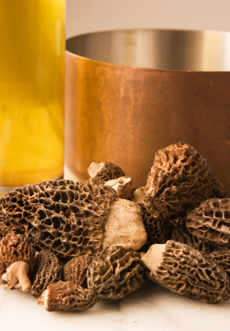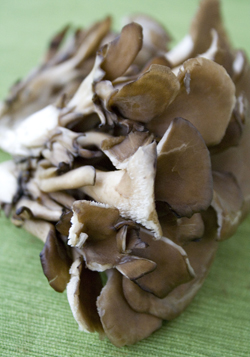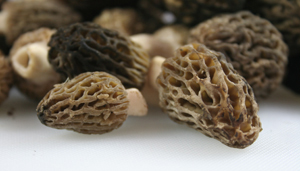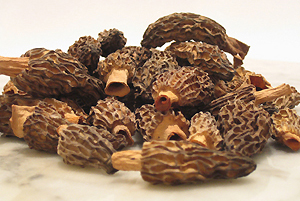
 Fire up the stove! Exotic, delicious wild morels are a fleeting spring vegetable (though available dried year-round). Photo by Yin Yang | IST.
Fire up the stove! Exotic, delicious wild morels are a fleeting spring vegetable (though available dried year-round). Photo by Yin Yang | IST.
|
KAREN HOCHMAN is Editorial Director of THE NIBBLE.
|
|
June 2008
|
 |
Meet The Morel
Part II: Buying & Preparing Morel Mushrooms
This is Part II of a three-part article. Use the index below to click among the sections.
IN PART II
Buying Fresh Morels
As with all produce, morels are graded; #1 grade, sold by the finest purveyors, means that each mushroom is a whole, young specimen with white stems, free of blemishes. Pristine and beautiful they make a stunning presentation sautéed and served as a side or atop pasta or risotto. If you can’t find top-quality morels in your area, you can buy them online at MarxFoods.com (when fresh morels aren’t in season, they sell dried morels).
Unlike some other wild mushrooms that are now cultivated as well as found in the wild (crimini and portabella as well as such exotics as the king trumpet and the maitake), morels are not yet cultivated on a commercial scale, although kits are sold to grow them in one’s backyard (if only we had a backyard, we’d try it!). Attempts to date to produce morels on a large-scale basis have been costly and unsuccessful.
That makes morels all the more exciting when they appear in forests each spring. A search on the internet shows a surprising number of morel-hunting groups, sharing both information on when the first treasures have been spotted in their areas, and “bragging rights” with photos of enormous and/or rare specimens. Most hunters appear not to be foodies or gourmets, but everyday folk whose favorite preparation is more likely to be battered and fried morels, rather than the recipes suggested below.
|

Golden Gourmet Mushrooms is an organic cultivator, growing year-round four types of
exotic mushrooms once available only wild in season: brown and white beech mushrooms,
king trumpets and maitakes (above). Photo by Claire Freierman. |
A season’s yield can fluctuate widely, depending on air temperatures, ground temperature and amount of rainfall. The greater the yield, the lower the price, and vice versa; availability and price can rise and fall throughout the season. “Morels are a very special product and it’s worth it to keep an eye on prices. Jump on the opportunity when they’re most affordable,” advises Marx Foods CEO Justin Marx.
Morel mushrooms will stay fresh for up to ten days if stored correctly, refrigerated in a  paper bag. Of course, that’s 10 days from when they were picked; two or three days after you buy them is your best bet. paper bag. Of course, that’s 10 days from when they were picked; two or three days after you buy them is your best bet.
Photo: Fresh morels. Photo by Ryan Clark | MarxFoods.com.
- Only purchase mushrooms that look fresh and dry. The caps should be intact—no tearing, bruising or shriveling. The stems should be firm with a uniform white color.
- Avoid any mushroom that feels slimy or has an off odor.
- Store morels (and any mushrooms) in a brown paper bag in the refrigerator—never in plastic. Plastic traps moisture, and sliminess can develop. While mushrooms are sold in plastic wrap, it is typically a special wrap with tiny holes to allow aeration.
- If you can’t use them (or all of them) within the peak freshness period, you can dry them or freeze them (sauté them in butter, then freeze). Freeze them in small packets in quantities you might need for a particular dish. Don’t defrost them prior to use, but toss them right into the soup, frying pan or other cooking vessel.
Dried Morels
While nothing beats the flavor and texture of a fresh mushroom, dried mushrooms work very well in certain recipes. If your  only access is to dried morels, they reconstitute nicely in water and are excellent additions to soups, sauces and gravies (less so in a vegetable sauté or other dish where the mushroom is the main focus). only access is to dried morels, they reconstitute nicely in water and are excellent additions to soups, sauces and gravies (less so in a vegetable sauté or other dish where the mushroom is the main focus).
To cook with dried mushrooms, first cover them with warm water and soak for 10 minutes. Drain them, change the water, and soak for another 10 to 15 minutes. Then cook per the recipe’s directions. If you can take advantage of the opportunity, save the soaking water for another purpose—cooking pasta or poaching chicken, for example. You can use it as is or reduce it for a sauce or gravy requiring just a few tablespoons of water.
Photo above: fresh morels from CaviarRusse.com.
Cleaning Fresh Morels
Those attractive honeycomb caps require extra attention when cleaning. The combs retain more earth than traditional mushroom gills, and can attract small insects. Some experts suggest soaking fresh mushrooms, others strongly advise against it, suggesting runing them under water and using a small brush to clean the combs. Marx Foods recommends these two techniques:
- Submerge morels in a bowl of water with a few pinches of salt.
- Place a plate on top of the mushrooms to ensure they’re completely immersed in the water and refrigerate for one hour.
-OR-
- Put the morels on a cookie sheet or in a baking dish or pan and place in a 140°F oven for 10 minutes.
- Remove and give the mushrooms a quick rinse.
Ready to cook?
Continue to Part III: Morel Recipes
Return To Article Index, Above
Lifestyle Direct, Inc. All rights reserved. Images are the copyright of their respective owners.

|






 paper bag. Of course, that’s 10 days from when they were picked; two or three days after you buy them is your best bet.
paper bag. Of course, that’s 10 days from when they were picked; two or three days after you buy them is your best bet.  only access is to dried morels, they reconstitute nicely in water and are excellent additions to soups, sauces and gravies (less so in a vegetable sauté or other dish where the mushroom is the main focus).
only access is to dried morels, they reconstitute nicely in water and are excellent additions to soups, sauces and gravies (less so in a vegetable sauté or other dish where the mushroom is the main focus).